Euregio-JungforscherInnenpreis
2025 wurden bereits zum 14. Mal Nachwuchsforscher:innen aus der Europaregion Tirol-Südtirol-Trentino eingeladen, ihre Forschungsarbeiten zum Thema "Wettbewerbsfähigkeit und Standort Euregio" einzureichen.
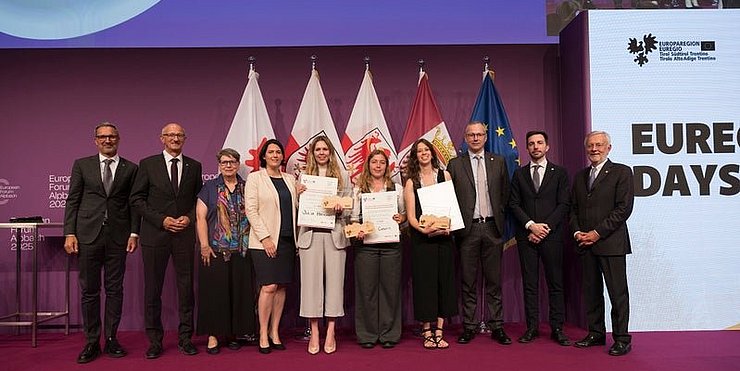
Die Verleihung des Euregio-JungforscherInnenpreises 2025 bei European Forum Alpbach: (v.l.) LH Arno Kompatscher (Südtirol), LH Anton Mattle (Tirol), Präsidentin Ulrike Tappeiner (Jurypräsident und Präsidentin Freie Universität Bozen), Präsidentin Barbara Thaler (Wirtschaftskammer Tirol), Julia Hofmann (3. Platz), Eva Casotti (1. Platz), Elena Fogazzi (2. Platz), Präsident Andrea De Zordo (Handelskammer Trient), Landesrat Simone Marchiori (Trentino) und Präsident Michl Ebner (Handelskammer Bozen). © Land Tirolo/Sedlak
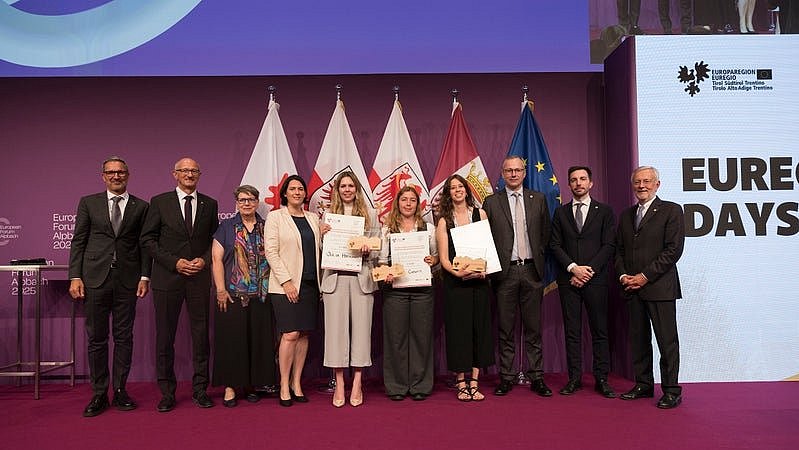
Anlässlich der Euregio-Days 2025 in Alpbach, die sich dem Thema „Wettbewerbsfähigkeit und Standort Euregio“ widmeten, konnten Nachwuchsforscher:innen unter 35 (Stichtag: 15.08.1990) ihre Arbeiten einreichen, vorstellen und sich mit renommierten Wissenschaftler:innen und politischen Verantwortungsträger:innen austauschen.
Die Gewinnerinnen und die Siegerprojekte 2025
Alle Infos über die Verleihung des Euregio-JungforscherInnenpreises 2025 findest du hier.
Ester Platz: Eva Casotti
Institute for Quantum Optics and Quantum Information Innsbruck, University of Innsbruck
Projekt: Observation of vortices in a dipolar supersolid
Supersolide sind exotische Materiezustände, die gleichzeitig feste und suprafluide Eigenschaften aufweisen. In diesen Systemen ordnen sich die Atome in einer kristallähnlichen Struktur an, während sie gleichzeitig reibungsfrei fließen können. Supersolidität wurde erstmals in festem Helium vorhergesagt, konnte jedoch kürzlich in ultrakalten dipolaren Atomgasen realisiert werden. Die kristallartige Dichtemodulation lässt sich in situ beobachten, während Phasenkohärenz durch Interferenzmuster erschlossen werden kann. Quantisierte Wirbel – das charakteristische Merkmal der Suprafluidität – waren bislang jedoch nicht nachgewiesen worden. Hier berichten wir über die theoretische Untersuchung und die erste experimentelle Beobachtung von Wirbeln in einem dipolaren Supersolid aus Dysprosium. Die Wirbel zeigen sich als Dichteeinbrüche und Phasenwindungen in Time-of-Flight-Bildern. Unter Rotation zeigt das System sowohl merkmalsfreie (irrotationale) Strömung als auch Eigenschaften starrer Körper – ein Hinweis auf die doppelte Natur der Supersolidität. Diese Ergebnisse könnten zum besseren Verständnis von Neutronensternen beitragen, in denen supersolid-ähnliche Phasen vermutet werden.
Zweiter Platz: Elena Fogazzi
Department of Physics, University of Trento
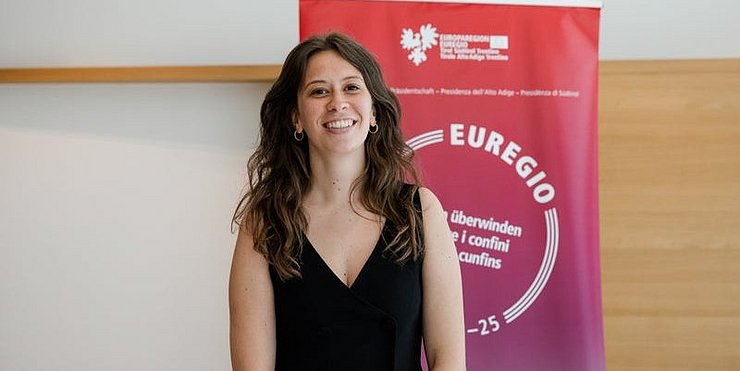
Zweiter Platz: Elena Fogazzi © EFA/Philipp Huber
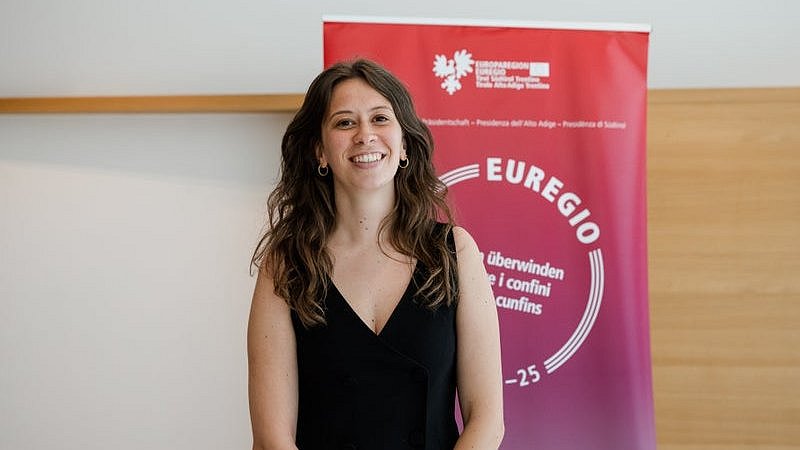
Projekt: Proton Computed Tomography: a novel imaging tool for proton therapy
Die Protonentherapie ist eine fortschrittliche Strahlentherapieform, die aufgrund der einzigartigen physikalischen Eigenschaften von Protonen eine hervorragende Dosislokalisierung und eine geringere Schädigung des gesunden Gewebes ermöglicht. Die genaue Bestimmung der Reichweite von Protonen und ihrer Wechselwirkungen mit Gewebe ist für die Optimierung der Protonentherapie von entscheidender Bedeutung, wobei die Bremsleistung (stopping power) von biologischem Gewebe der wichtigste Parameter ist. Unser Projekt schlägt eine neuartige Methode zur direkten Messung der Bremsleistungskarte unter Verwendung eines Protonen-Computertomographiesystems vor, das vom INFN, der Universität Trient und dem Krankenhaus Trient entwickelt wurde. Das System wurde für den klinischen Einsatz und die Kalibrierungsentwicklung charakterisiert und zeigt vielversprechende Bildgebungsleistungen. Auf dieser Grundlage wurde seine mögliche Integration in die Behandlungsplanung entworfen und validiert. Nach ersten Tests im Protonentherapiezentrum Trient wurde seine Anwendung im Rahmen einer experimentellen Studie auf andere europäische Zentren ausgeweitet. Die Ergebnisse bestätigen die Protonenbildgebung als Instrument für eine genaue Behandlungsplanung und zukünftige Fortschritte in der Protonentherapie.
Dritter Platz: Julia Hofmann
Medical University of Innsbruck
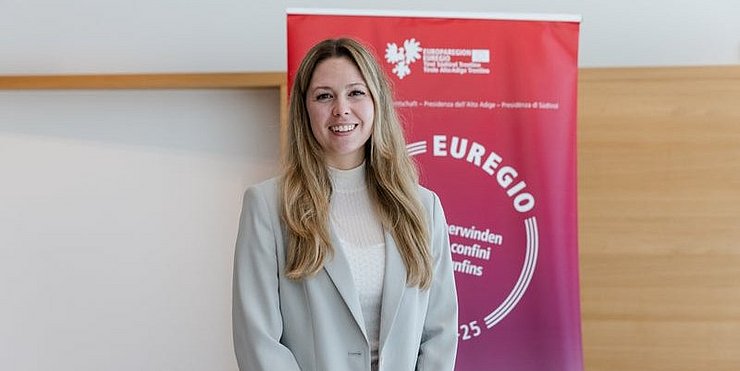
Dritter Platz: Julia Hofmann © EFA/Philipp Huber
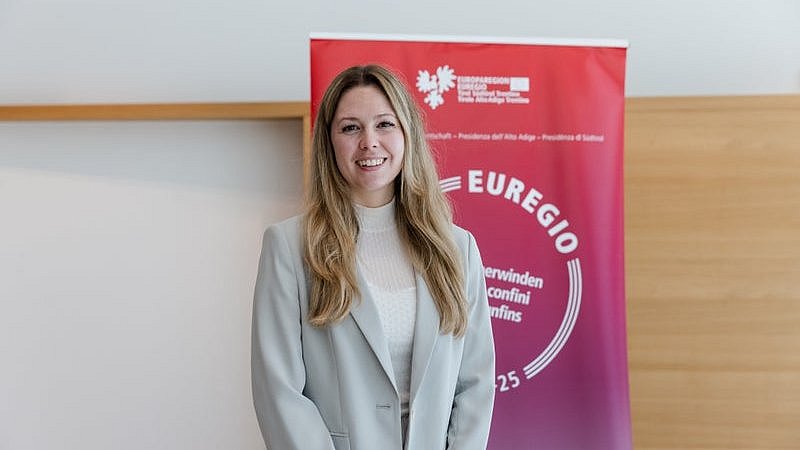
Projekt: Bioenergetic Function: A Predictive Biomarker to Expand the Donor Pool for Liver Transplantation
Die Lebertransplantation stellt für viele PatientInnen mit terminaler Lebererkrankung die einzige kurative Therapieoption dar. Jedoch übersteigt die Nachfrage an Spenderorganen das Angebot bei Weitem. Eine präzise Beurteilung der Organqualität noch vor der Transplantation ist daher unerlässlich, um alle optimalen Spenderlebern zu identifizieren, welche für eine erfolgreiche Transplantation geeignet sind. Mithilfe der normothermen Maschinenperfusion (NMP), einer innovativen Methode zur Organkonservierung, können Spenderlebern außerhalb des Körpers bei 37°C erhalten werden. Dies ermöglicht eine umfassende Beurteilung der Organfunktion bereits vor der Transplantation. In dieser Studie zeigen wir, dass die Analyse der mitochondrialen Funktion, welche für die zelluläre Energiegewinnung essenziell ist, eine präzise Bewertung der bioenergetischen Funktion der Leber während der NMP ermöglicht. Auf diese Weise ermittelte mitochondriale Biomarker können den klinischen Verlauf nach der Transplantation zuverlässig voraussagen. So trägt diese Analyse dazu bei, die Auswahl geeigneter Spenderorgane zu verbessern, den verfügbaren Spenderpool zu erweitern und dem Organmangel in der Transplantationsmedizin entgegenzuwirken.
Euregio-Awards 2025
Finalist:innen 2025
Kategorie 1: Wirtschafts- und Sozialwissenschaften, Rechtswissenschaften, Bildungs- und Geisteswissenschaften
Marco Turrini
Career competences and employability growth through mentorship
This study demonstrates how mentoring programs can enhance the career competencies and employability of students transitioning into the labour market in the Euregio. The research adopted a multidisciplinary approach that integrates psychology, pedagogy, and organizational science. Overall, 222 participants have been intensively monitored via questionnaires throughout their mentoring program. The results indicate that mentorship process factors such as perceived deep similarity, feedback quality, and proactive career behaviors positively influence career competences and employability. The study provides evidence-based insights to optimize mentoring programs and contributes to understanding how career sustainability can promote long-term competitiveness.
Valentin Wett
Pathways to Integration: The Effect of Apprenticeships in Understaffed Professions on Refugee Employment
This study evaluates Austria’s apprenticeship policy (2012–2018), which allowed asylum seekers to start vocational apprenticeships in shortage occupations during the asylum process. Using a fuzzy Regression Discontinuity Design and focusing on Afghan men aged 14–33 in Western Austria, it finds that participants gained 935 additional employment days, earned €67,759 more, and relied significantly less on welfare benefits over five years. Robustness checks confirm causal effects, showing no effect for Syrian asylum seekers, who were less exposed to the policy due to generally shorter asylum processes. Structured apprenticeships can accelerate refugees’ labor market integration and may improve regional economic resilience amid persistent skilled labor shortages. These findings are highly relevant for Euregio, where demographic shifts and labor shortages affect all three regions similarly and businesses increasingly face global competition from countries less affected by such constraints.
Kategorie 2: Technische Wissenschaften, Naturwissenschaften und Medizin
Eva Casotti
Observation of vortices in a dipolar supersolid
Supersolids are exotic states of matter that exhibit both solid and superfluid properties simultaneously. In these systems, atoms arrange themselves in a crystal-like structure while maintaining frictionless flow. First predicted in solid helium, supersolidity has recently been realized in ultracold dipolar atomic gases. The crystal-like density modulation is observed in situ, whereas phase coherence can be inferred through interference patterns. However, quantized vortices—the hallmark of superfluidity—had not yet been observed. We report on the theoretical investigation and the first experimental observation of vortices in a dipolar supersolid of dysprosium. Vortices appear as density depletions and phase windings in time-of-flight images. Under rotation, the system exhibits both irrotational flow and rigid-body characteristics, revealing the dual nature of supersolidity. These results may help us further understand neutron stars, where supersolid-like phases are believed to exist.
Elena Fogazzi
Proton Computed Tomography: a novel imaging tool for proton therapy
Proton therapy is an advanced radiotherapy modality offering superior dose localization and reduced damage to healthy tissues, due to the unique physical properties of protons. Accurate determination of proton range and tissue interactions is essential to optimize proton therapy, with stopping power values of biological tissues being the key parameter. Our project proposes a novel method to directly measure the stopping power map using a proton computed tomography system developed by INFN, University of Trento and Trento Hospital. The system has been characterized for clinical use and calibration development, showing promising imaging performance. Based on that, its potential integration into treatment planning has been designed and validated. First tested at the Trento Proton Therapy Center, an experimental survey extended its application to other European centers. The results support proton imaging as a tool for accurate treatment planning and future proton therapy advancements.
Julia Hofmann
Bioenergetic Function: A Predictive Biomarker to Expand the Donor Pool for Liver Transplantation
Liver transplantation remains the only curative option for many patients with end-stage liver disease, yet the demand for donor organs far exceeds the supply. Accurate assessment of organ quality prior to transplantation is therefore essential to identify all suitable donor livers. Normothermic machine perfusion (NMP), a transformative organ preservation technique, maintains donor livers at 37°C extracorporeally on an artificial blood circuit, enabling real-time functional evaluation. In this study, we show that analyzing mitochondrial function—crucial for cellular energy production—provides valuable insight into the liver’s bioenergetic function during NMP. Mitochondrial biomarkers assessed in this way reliably predict clinical outcomes after transplantation. This approach helps to enhance donor organ selection, to expand the available donor pool, and to counteract the ongoing organ shortage in transplantation medicine.
Hamed Saleh
Integrating Sustainable Electronics and Artificial Intelligence for Plant Health Monitoring: Potential Tools for the Future of Euregio’s Agriculture
This research presents a sustainable approach to plant health monitoring, integrating electrical bioimpedance spectroscopy with machine learning for early detection of water and iron stress in tomato plants. Over 8000 measurements per condition were collected under controlled conditions, with classification models achieving high F1 scores (0.89–0.93). To enhance sustainability, tomato plant waste was converted into biodegradable electrodes using graphene nanoplatelets, yielding composite films with electrical resistivity of 0.46 Ω · m. These materials showed strong performance and durability in bioimpedance sensing. The work supports Agriculture 4.0 and aligns with the United Nations Sustainable Development Goals by promoting precision agriculture and circular bioeconomy.
Die Abstracts der Finalist:innen in deutscher und italienischer Sprache finden Sie hier.
Downloads
Hier geht's zu den voherigen Ausgaben:
Kontakt








